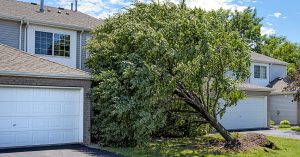“Responsibility for Tree Branches & Roots” – CAI South Gulf Coast Magazine
 Who is responsible for a tree branch that perilously hangs over a neighbor’s house or yard? Who is responsible for tree roots that are damaging a sidewalk or driveway?
Who is responsible for a tree branch that perilously hangs over a neighbor’s house or yard? Who is responsible for tree roots that are damaging a sidewalk or driveway?
Florida common law provides that a property owner (owner of the tree) does not owe a duty to remove or trim tree branches or roots or other vegetation encroaching onto neighboring property and does not recognize a cause of action for negligence or nuisance for failure to do so. Therefore, the owner of the tree will not be liable for the damage caused to a neighboring property.
With respect to negligence, in 1984, the Third District Court of Appeals recognized a landowner’s right to cut off any intruding roots or branches at the property line. In light of this right, the Court held that there was no right to file a negligence suit for the failure to keep a tree properly trimmed so that it does not extend over and onto another individual’s property.
With respect to nuisance, in a 1987 case, the Third District Court of Appeals found that the landowner is not liable to persons outside the land for a nuisance resulting from trees and natural vegetation growing on the land. Further, this Court found that the adjoining property owner can trim back, at the adjoining owner’s own expense, any encroaching tree roots or branches and other vegetation which has grown onto his/her property.
The Third District Court of Appeals held: “the underlying rationale for this well-settled law is that it is wiser to leave the individual to protect himself, if harm results to him from this exercise of another’s right to use his property in a reasonable way, that to subject that other to the annoyance, and the public to to the burden, of actions at law, which would be likely to be innumerable and, in many instances, purely vexatious.”
Accordingly, even if the trees located on another’s property are the cause of the damage, the only available remedy to the damaged property owner is to protect himself or herself by trimming any roots or branches that encroach across the property line, at his or her own expense. Although the damage was caused by the trees, the owner of the damaged property remains responsible to repair and maintain his or her own property, and as such, liability does not transfer to the tree owner.
To read the original CAI Community Voice article, please click here.
Elizabeth “Beth” A. Lanham-Patrie is a Board Certified Specialist in Condominium and Planned Development Law. She provides a variety of legal services to condominium, homeowner, and cooperative associations, and regularly drafts and amends governing documents, prepares and reviews contracts, and resolves disputes between associations and owners. To learn more about Beth, please click here.





